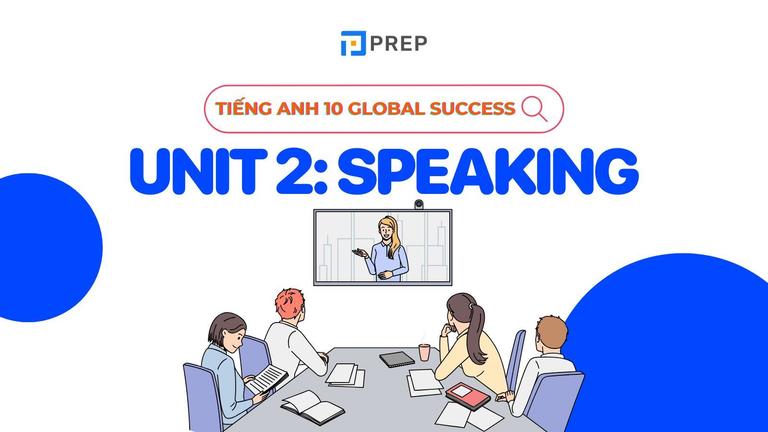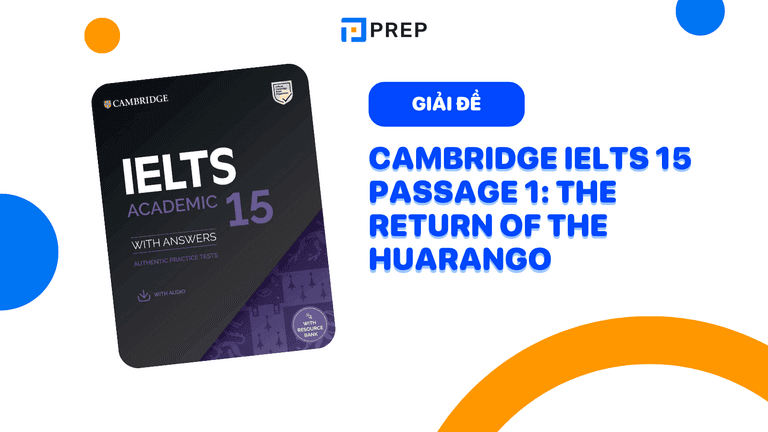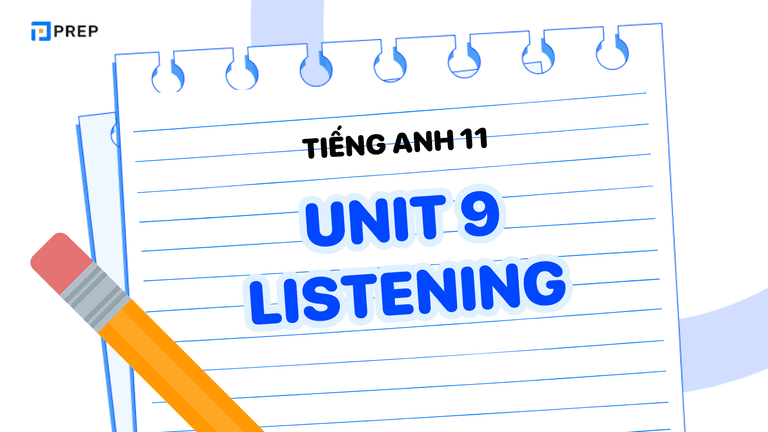Câu hỏi và đáp án bài Reading Test 4 passage 3 - IELTS Cambridge 15 - Environmental practices of big businesses.
Bài đọc trong Cambridge IELTS 15 Test 4 Reading Passage 3 có tiêu đề Environmental Practices of Big Businesses tập trung vào cách các doanh nghiệp lớn có thể tác động đến môi trường và những yếu tố ảnh hưởng đến các quyết định của họ. Cụ thể, tác giả phân tích rằng nhiều doanh nghiệp sẵn sàng hy sinh môi trường và sức khỏe cộng đồng để tối đa hóa lợi nhuận trong ngắn hạn. Trong bài viết sau đây, cùng Prep phân tích chi tiết đáp án và take note một số từ vựng quan trọng để hiểu rõ hơn nội dung của bài đọc này nhé!

I. Đề bài IELTS Cambridge 15 Test 4 Reading passage 3 Environmental practices of big businesses
Environmental practices of big businesses
The environmental practices of big businesses are shaped by a fundamental fact that for many of us offends our sense of justice. Depending on the circumstances, a business may maximize the amount of money it makes, at least in the short term, by damaging the environment and hurting people. That is still the case today for fishermen in an unmanaged fishery without quotas, and for international logging companies with short-term leases on tropical rainforest land in places with corrupt officials and unsophisticated landowners. When government regulation is effective, and when the public is environmentally aware, environmentally clean big businesses may out-compete dirty ones, but the reverse is likely to be true if government regulation is ineffective and if the public doesn't care.
It is easy for the rest of us to blame a business for helping itself by hurting other people. But blaming alone is unlikely to produce change. It ignores the fact that businesses are not charities but profit-making companies, and that publicly owned companies with shareholders are under obligation to those shareholders to maximize profits, provided that they do so by legal means. US laws make a company's directors legally liable for something termed "breach of fiduciary responsibility" if they knowingly manage a company in a way that reduces profits. The car manufacturer Henry Ford was in fact successfully sued by shareholders in 1919 for raising the minimum wage of his workers to $5 per day: the courts declared that, while Ford's humanitarian sentiments about his employees were nice, his business existed to make profits for its stockholders.
Our blaming of businesses also ignores the ultimate responsibility of the public for creating the conditions that let a business profit through destructive environmental policies. In the long run, it is the public, either directly or through its politicians, that has the power to make such destructive policies unprofitable and illegal, and to make sustainable environmental policies profitable.
The public can do that by suing businesses for harming them, as happened after the Exxon Valdez disaster, in which over 40,000m³ of oil were spilled off the coast of Alaska. The public may also make their opinion felt by preferring to buy sustainably harvested products; by making employees of companies with poor track records feel ashamed of the company and complain to their own management; by preferring their governments to award valuable contracts to businesses with a good environmental track record; and by pressing their governments to pass and enforce laws and regulations requiring good environmental practices.
In turn, big businesses can exert powerful pressure on any suppliers that might ignore public or government pressure. For instance, after the US public became concerned about the spread of a disease known as BSE, which was transmitted to humans through infected meat, the US government's Food and Drug Administration introduced rules demanding that the meat industry abandon practices associated with the risk of the disease spreading. But for five years the meat packers refused to follow these, claiming that they would be too expensive to obey. However, when a major fast-food company then made the same demands after customer purchases of its hamburgers plummeted, the meat industry complied within weeks. The public's task is therefore to identify which links in the supply chain are sensitive to public pressure: for instance, fast-food chains or jewelry stores, but not meat packers or gold miners.
Some readers may be disappointed or outraged that I place the ultimate responsibility for business practices harming the public on the public itself. I also believe that the public must accept the necessity for higher prices for products to cover the added costs, if any, of sound environmental practices. My views may seem to ignore the belief that businesses should act in accordance with moral principles even if this leads to a reduction in their profits. But I think we have to recognize that, throughout human history, in all politically complex human societies, government regulation has arisen precisely because it was found that not only did moral principles need to be made explicit, they also needed to be enforced.
To me, the conclusion that the public has the ultimate responsibility for the behavior of even the biggest businesses is empowering and hopeful, rather than disappointing. My conclusion is not a moralistic one about who is right or wrong, admirable or selfish, a good guy or a bad guy. In the past, businesses have changed when the public came to expect and require different behavior, to reward businesses for behavior that the public wanted, and to make things difficult for businesses practicing behaviors that the public didn't want. I predict that in the future, just as in the past, changes in public attitudes will be essential for changes in businesses' environmental practices.
Questions 27-31
Complete the summary using the list of words, A-J, below.
Write the correct letter, A-J, in boxes 27-31 on your answer sheet.
Big businesses
Many big businesses today are prepared to harm people and the environment in order to make money, and they appear to have no 27 .............................. . Lack of 28 .............................. by governments and lack of public 29 .............................. can lead to environmental problems such as 30 .............................. or the destruction of 31 ..............................
|
A |
funding |
|
B |
trees |
|
C |
rare species |
|
D |
moral standards |
|
E |
control |
|
F |
involvement |
|
G |
flooding |
|
H |
overfishing |
|
I |
worker support |
Questions 32-34
Choose the correct letter, A, B, C or D.
Write the correct letter in boxes 32-34 on your answer sheet.
32 The main idea of the third paragraph is that environmental damage
A requires political action if it is to be stopped.
B is the result of ignorance on the part of the public.
C could be prevented by the action of ordinary people.
D can only be stopped by educating business leaders.
33 In the fourth paragraph, the writer describes ways in which the public can
A reduce their own individual impact on the environment.
B learn more about the impact of business on the environment.
C raise awareness of the effects of specific environmental disasters.
D influence the environmental policies of businesses and governments.
34 What pressure was exerted by big business in the case of the disease BSE?
A Meat packers stopped supplying hamburgers to fast-food chains.
B A fast-food company forced their meat suppliers to follow the law.
C Meat packers persuaded the government to reduce their expenses.
D A fast-food company encouraged the government to introduce legislation.
Questions 35-39
Do the following statements agree with the claims of the writer in Reading Passage 3?
In boxes 35-39 on your answer sheet, write
YES if the statement agrees with the claims of the writer
NO if the statement contradicts the claims of the writer
NOT GIVEN if it is impossible to say what the writer thinks about this
35 The public should be prepared to fund good environmental practices.
36 There is a contrast between the moral principles of different businesses.
37 It is important to make a clear distinction between acceptable and unacceptable behaviour.
38 The public have successfully influenced businesses in the past.
39 In the future, businesses will show more concern for the environment.
Question 40
Choose the correct letter, A, B, C or D.
Write the correct letter in box 40 on your answer sheet.
40 What would be the best subheading for this passage?
A Will the world survive the threat caused by big businesses?
B How can big businesses be encouraged to be less driven by profit?
C What environmental dangers are caused by the greed of businesses?
D Are big businesses to blame for the damage they cause the environment?
Reading Passage 3, Questions 27-40
-
D
-
E
-
F
-
H
-
B
-
C
-
D
-
B
-
YES
-
NOT GIVEN
-
NO
-
YES
-
NOT GIVEN
-
D

II. Đáp án bài đọc
Reading Passage 3, Questions 27-40
-
D
-
E
-
F
-
H
-
B
-
C
-
D
-
B
-
YES
-
NOT GIVEN
-
NO
-
YES
-
NOT GIVEN
-
D
III. Giải thích đáp án chi tiết
27. D (moral standards)
-
Đoạn 1: nhiều doanh nghiệp sẵn sàng hủy hoại môi trường vì lợi nhuận, dường như không có chuẩn mực đạo đức.
Đáp án: moral standards.
28. E (control)
-
Nếu thiếu sự kiểm soát (control) của chính phủ → doanh nghiệp "dirty" sẽ thắng thế.
Đáp án: control.
29. F (involvement)
-
Nếu công chúng không quan tâm/tham gia (lack of public involvement) thì các chính sách môi trường không được thực thi.
Đáp án: involvement.
30. H (overfishing)
-
Đoạn 1: ví dụ fishermen in an unmanaged fishery without quotas → dẫn đến overfishing.
Đáp án: overfishing.
31. B (trees)
-
Đoạn 1: logging companies with short-term leases on tropical rainforest land → phá hủy trees.
Đáp án: trees.
32. C (could be prevented by the action of ordinary people)
-
Đoạn 3: công chúng mới là người có ultimate responsibility, có thể ngăn chặn bằng hành động (mua hàng bền vững, kiện doanh nghiệp...).
Đáp án: C.
33. D (influence the environmental policies of businesses and governments)
-
Đoạn 4: công chúng có thể mua hàng bền vững, gây sức ép lên chính phủ/doanh nghiệp → ảnh hưởng đến chính sách môi trường.
Đáp án: D.
34. B (A fast-food company forced their meat suppliers to follow the law)
-
Đoạn 5: meat packers không tuân theo luật trong 5 năm, nhưng khi fast-food company gây áp lực thì họ tuân thủ trong vài tuần.
Đáp án: B.
35. YES
-
Đoạn 6: the public must accept the necessity for higher prices for products to cover added costs of environmental practices.
Công chúng cần sẵn sàng trả thêm tiền → YES.
36. NOT GIVEN
-
Bài không so sánh nguyên tắc đạo đức giữa các doanh nghiệp, chỉ nói họ bị ràng buộc bởi lợi nhuận.
NOT GIVEN.
37. NO
-
Đoạn 6: tác giả nói không dựa trên "moralistic" (ai đúng ai sai), mà tập trung vào sức mạnh của công chúng, không phải rạch ròi phân biệt hành vi tốt/xấu.
NO.
38. YES
-
Đoạn 7: In the past, businesses have changed when the public came to expect and require different behavior.
YES.
39. NOT GIVEN
-
Tác giả dự đoán tương lai: thay đổi của doanh nghiệp phụ thuộc vào công chúng, nhưng không khẳng định chắc chắn doanh nghiệp sẽ quan tâm hơn đến môi trường.
NOT GIVEN.
40. D (Are big businesses to blame for the damage they cause the environment?)
-
Toàn bài xoay quanh: trách nhiệm chính thuộc về công chúng, chứ không chỉ đổ lỗi cho doanh nghiệp.
-
Đáp án đúng: D.
Xem thêm: Đề bài và đáp án chi tiết Cambridge IELTS 15 Passage 1: The Return of the Huarango
IV. Từ vựng quan trọng trong bài
|
Từ vựng |
Giải nghĩa |
Ví dụ |
|
maximize profits |
tối đa hóa lợi nhuận |
Many companies focus on maximizing profits at the cost of the environment. (Nhiều công ty tập trung vào việc tối đa hóa lợi nhuận mà không quan tâm đến môi trường.) |
|
unsophisticated landowners |
chủ đất thiếu hiểu biết |
The unsophisticated landowners were unaware of the value of their land. (Những chủ đất thiếu hiểu biết không nhận thức được giá trị của mảnh đất của họ.) |
|
government regulation |
quy định của chính phủ |
Government regulations are crucial to protect the environment. (Quy định của chính phủ là rất quan trọng để bảo vệ môi trường.) |
|
fiduciary responsibility |
trách nhiệm ủy thác (nghĩa vụ pháp lý với cổ đông) |
The CEO must fulfill their fiduciary responsibility to shareholders. (Giám đốc điều hành phải thực hiện trách nhiệm ủy thác đối với các cổ đông.) |
|
lawsuit |
vụ kiện |
The company faced a lawsuit after the environmental disaster. (Công ty đã phải đối mặt với một vụ kiện sau thảm họa môi trường.) |
|
sustainable practices |
thực hành bền vững |
Adopting sustainable practices can reduce a company’s environmental impact. (Áp dụng thực hành bền vững có thể giảm tác động môi trường của công ty.) |
|
track record |
thành tích, hồ sơ (của công ty/doanh nghiệp) |
This company has a strong track record in reducing carbon emissions. (Công ty này có thành tích vững trong việc giảm khí thải carbon.) |
|
supply chain |
chuỗi cung ứng |
It’s important to ensure the supply chain follows ethical environmental practices. (Điều quan trọng là đảm bảo chuỗi cung ứng tuân thủ các thực hành môi trường đạo đức.) |
|
enforce laws |
thực thi luật |
Governments need to enforce laws to protect natural resources. (Chính phủ cần thực thi luật để bảo vệ tài nguyên thiên nhiên.) |
|
plummet |
giảm mạnh (doanh số, giá...) |
The price of oil has plummeted due to a global decrease in demand. (Giá dầu đã giảm mạnh do sự suy giảm cầu toàn cầu.) |
|
empowering |
trao quyền, khích lệ |
Empowering consumers to make ethical choices can drive business change. (Khích lệ người tiêu dùng đưa ra các lựa chọn đạo đức có thể thúc đẩy sự thay đổi trong doanh nghiệp.) |
|
public attitudes |
thái độ của công chúng |
Changing public attitudes is essential for businesses to adopt eco-friendly policies. (Thay đổi thái độ của công chúng là điều cần thiết để các doanh nghiệp áp dụng các chính sách thân thiện với môi trường.) |

Trên đây là đề bài và đáp án bài đọc IELTS Cambridge IELTS 15 Test 4 Reading passage 3 Environmental practices of big businesses kèm một số từ vựng hay cần ghi nhớ trong bài. Hy vọng tài liệu trên sẽ hữu ích cho quá trình luyện thi IELTS của bạn.
Học tiếng Anh online dễ dàng hơn với PREP - Nền tảng Học & Luyện thi thông minh cùng AI. Nhờ công nghệ AI độc quyền, bạn có thể tự học trực tuyến ngay tại nhà, chinh phục lộ trình học IELTS, TOEIC, tiếng Anh giao tiếp hiệu quả. Bên cạnh đó, học viên còn có sự hỗ trợ tuyệt vời từ Teacher Bee AI, trợ lý ảo giúp bạn giải đáp thắc mắc và đồng hành 1-1 trong suốt quá trình học tập. Hãy click TẠI ĐÂY hoặc liên hệ HOTLINE 0931428899 để nhận tư vấn chi tiết về các khóa học tiếng Anh chất lượng nhất thị trường!
Tải ngay app PREP để bắt đầu hành trình học tiếng Anh tại nhà với chương trình học luyện thi online chất lượng cao.

Chào bạn! Mình là Hiền Hoàng, hiện đang đảm nhận vai trò quản trị nội dung sản phẩm tại Blog của website prepedu.com.
Với hơn 5 năm tự học các ngoại ngữ như tiếng Anh, tiếng Trung và ôn luyện một số kỳ thi IELTS, TOEIC, HSK, mình đã tự đúc rút được nhiều kinh nghiệm để hỗ trợ hàng nghìn người đang gặp khó khăn trong việc học ngoại ngữ. Hy vọng rằng những chia sẻ phía trên sẽ giúp ích cho bạn trong quá trình tự ôn luyện thi hiệu quả tại nhà!
Bình luận
Nội dung premium
Xem tất cảLộ trình cá nhân hoá
Có thể bạn quan tâm
Kết nối với Prep
MSDN: 0109817671.
Địa chỉ liên hệ: Tòa nhà Vinaconex, 34 Láng Hạ, phường Láng, TP Hà Nội.
Địa chỉ kinh doanh: Lô 21 C2 Khu đô thị Nam Trung Yên, phường Yên Hòa, TP Hà Nội.
Trụ sở: Số nhà 20, ngách 234/35 đường Hoàng Quốc Việt, phường Nghĩa Đô, TP Hà Nội.
Phòng luyện ảo - Trải nghiệm thực tế - Công nghệ hàng đầu.
Hotline: 0931 42 8899.
Trụ sở: Số nhà 20, ngách 234/35 đường Hoàng Quốc Việt, phường Nghĩa Đô, TP Hà Nội.
Giấy chứng nhận hoạt động đào tạo, bồi dưỡng số 1309/QĐ-SGDĐT ngày 31 tháng 07 năm 2023 do Sở Giáo dục và Đào tạo Hà Nội cấp.























